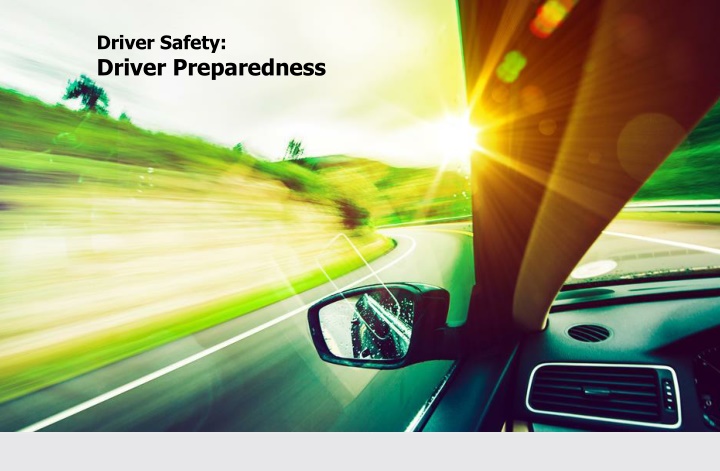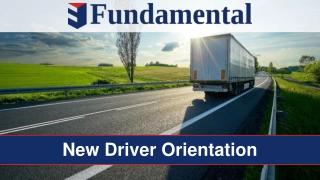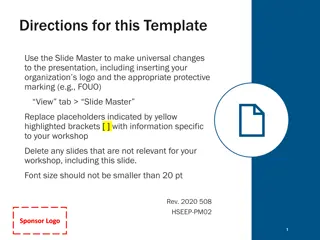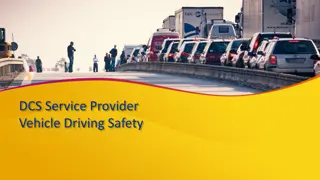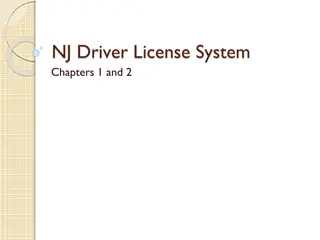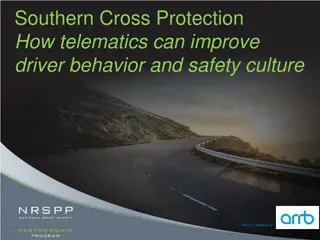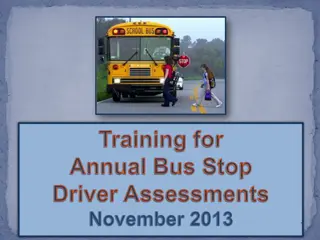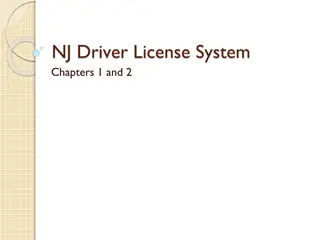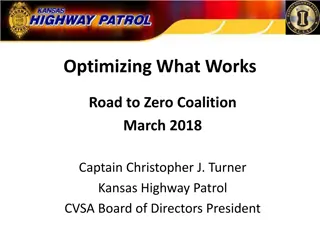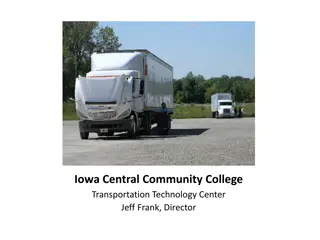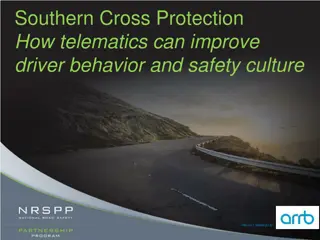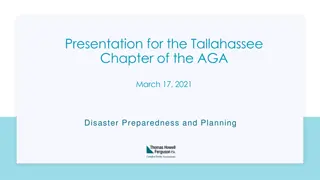Driver Safety: Vehicle Preparedness Training
This training material covers essential information on driver safety and preparedness, emphasizing the importance of knowing your vehicle, safety systems, and emergency preparedness. It guides drivers on proper vehicle maintenance, inspection, and responsibilities to ensure safe driving practices. The content aims to equip drivers with the knowledge and skills needed to handle various emergency situations on the road effectively.
Download Presentation

Please find below an Image/Link to download the presentation.
The content on the website is provided AS IS for your information and personal use only. It may not be sold, licensed, or shared on other websites without obtaining consent from the author.If you encounter any issues during the download, it is possible that the publisher has removed the file from their server.
You are allowed to download the files provided on this website for personal or commercial use, subject to the condition that they are used lawfully. All files are the property of their respective owners.
The content on the website is provided AS IS for your information and personal use only. It may not be sold, licensed, or shared on other websites without obtaining consent from the author.
E N D
Presentation Transcript
Driver Safety: Driver Preparedness
Introduction How to Use this Presentation DISCLAIMER This training material presents very important, pertinent information. It should not be assumed, however, that this program satisfies every legal requirement of every state. Some states require the training be developed and delivered by an individual with specific training and experience. This presentation contains base material for use in an instructor-led training setting. You may modify this presentation to satisfy the specific training needs of your organization. This training is AWARENESS LEVEL and does not authorize any person to perform work or validate their level of competency; it must be supplemented with operation and process- specific assessments and training, as well as management oversight, to assure that all training is understood and followed. On some slides, the display text is supplemented with additional material in the slide notes. This content is licensed for modification and use in a classroom setting. You may not redistribute this material in any form. Your organization must do an evaluation of all exposures and applicable codes and regulations. In addition, establish proper controls, training, and protective measures to effectively control exposures and assure compliance. This program is neither a determination that the conditions and practices of your organization are safe, nor a warranty that reliance upon this program will prevent accidents and losses or satisfy local, state, or federal regulations.
Driver Safety: Driver Preparedness 1. Know Your Vehicle 2. Safety Systems and Gear 3. Emergency Preparedness
Introduction With incidents ranging in severity from flat tires or running out of gas to sudden illnesses and major accidents, all drivers are likely to experience some sort of emergency at some point. You can minimize the chances of certain incidents by keeping your vehicle properly maintained. However, there are times when an emergency is unexpected or unavoidable. This course will help you to prepare you and your vehicle to safely manage any situations that might arise. The following slides contain: A list of vehicle components to check for proper condition or maintenance An overview of your vehicle s safety systems A guide for emergency preparedness
Know Your Vehicle Part 1 Knowing your vehicle s current condition is vital to assuring its safe use on the road. What you need to know: The elements of a once-over inspection The elements of a regular maintenance inspection How to assess your blind spots The importance of assessing your full vehicle dimensions
Your Responsibilities Know Your Vehicle It is your responsibility to: Drive your vehicle properly. Perform regular inspections. Follow your preventive maintenance procedures. Report problems with your vehicle, and assure that they are corrected. Never drive a vehicle that is unsafe.
Conduct a Once-Over Inspection Before Driving Know Your Vehicle This inspection checks for conditions that could lead to a breakdown or collision. Head and tail lights Brakes Tire Wear
Conduct Regular Maintenance Inspections Know Your Vehicle Check the following: Lights and signals Windshield and wipers Leaks
Conduct Regular Maintenance Inspections Know Your Vehicle Gauges You are responsible for checking the following: Emergency brake Fluid levels
Check Your Tires Regularly Know Your Vehicle Maintenance Tire pressure Signs of damage or wear
Know Your Blind Spots Know Your Vehicle Pre-driving Practices As speed increases, so does the size of your blind spots. As speed increases, so does the size of your blind spots.
Adjust Side Mirrors to Reduce Blind Spots Know Your Vehicle Have someone walk in both left and right blind spots. Set mirrors. Check mirrors. Re-adjust and check again.
Know the Height of Your Vehicle Know Your Vehicle The clearance you need changes with different loads in your vehicle. Do not forget about any objects that are stored in a rack on the top or may protrude from your vehicle. If you are not certain whether your vehicle has enough clearance to pass under an object, do not attempt the pass until you have confirmed that it is safe.
Know the Width of Your Vehicle Know Your Vehicle Do not forget to check the width of your vehicle, and assure that you have adequate side clearance. 8 6 2
Safety Systems and Gear Part 2 While the number of serious injuries and deaths associated with vehicle crashes are still significant, improvements in safety systems are saving more lives each day. What you need to know: Proper use of seat belts Airbag functionality and safety practices
Safety Systems and Gear Seat Belts Protective Controls Shoulder harnesses reduce the severity of injury by reducing the force absorbed by the head or chest. Seat belts: Increase chances of survival. Protect users from being thrown about the passenger compartment or ejected from the vehicle. Lap belts allow the hips to absorb much of the force of the collision. Keep the driver in position to attempt to regain control of the vehicle. Lap belts and shoulder harnesses must be used together.
Safety Systems and Gear Seat Belts Protective Controls While seat belts are widely used, some people may still offer excuses: In a crash at 30 MPH, a person weighing 165 lbs. bracing themselves is equivalent to pushing 3 tons of cement. Only .5% of all vehicle crashes involve fire or submersion. Passengers are 25 times more likely to be ejected from the vehicle if they do not wear safety belts.
Safety Systems and Gear Airbag Safety Protective Controls Airbags: Inflate in about 1/25 of a second following a crash. Do not require maintenance, but must be replaced upon deployment. Provide superior protection for front and side crashes (when side or curtain airbags are installed in the vehicle), but are intended as a supplement to seat belt use. More than half of all fatalities occur to front seat passengers.
Safety Systems and Gear Airbag Safety Pre-driving Practices Adjust your seat to accommodate airbags: Avoid the risk zone (the first 2 3 inches of inflation where the force is greatest). Leave at least 10 inches of clearance between the steering wheel and your breastbone. Know any restrictions for children. Make sure they meet height and weight requirements to sit in the front seat. All vehicles produced for sale in the United States after September 1998 have been required to contain front airbags for the driver and passenger, though many newer models include multiple airbags located throughout the entire vehicle compartment. Grip the wheel at four andeight o clock to assure your hands are protected under the airbag. Check your owner s manual for more information on airbag positioning or other requirements.
Part 3 Emergency Preparedness Being prepared for anything can keep minor incidents from becoming more serious. What you need to know: Emergency items What to do in the event of an emergency Special considerations for cold climates
Emergency Preparedness Emergency Items In the event of an emergency, you may need to rely on what you have in your vehicle for survival. A well-prepared vehicle should contain the following items: Jumper Cables Matches Spare Tire and Jack Water Flashlight Vest
Emergency Preparedness Emergency Items Items should also include the following: Flares or Emergency Signals Fire Extinguisher First Aid Kit Phone
Emergency Preparedness Reacting to an Emergency Most roadside emergencies occur with little warning. Keeping calm and knowing how to react is critical to assuring the safety of everyone in the vehicle, as well as in surrounding traffic. When the emergency occurs: Do not slam on the brakes. Maintain a firm grip on the steering wheel. Take your foot off the gas pedal. Move the vehicle towards the shoulder or exit. Use turn signals.
Emergency Preparedness Reacting to an Emergency Once your vehicle is safely to the side of the road: Keep away from traffic. Stay visible. Use hazard lights and emergency signals (e.g., reflective triangles or flares) as necessary, and wear a reflective vest. Stay with the vehicle. Only go outside if you can address the issue yourself (e.g., changing a flat tire or adding coolant). Call for roadside assistance if necessary. Do not stand directly in front or behind the vehicle.
Emergency Preparedness Preparing for Winter and Cold Weather Drivers in cold weather must take extra precautions. Check the condition of your tires, battery, and wiper blades. Assure that fluids, such as antifreeze and washer fluid, are at appropriate levels. Clear snow or ice from the vehicle before driving. Dress in layers of warm, lightweight clothing. Stock the vehicle with tire chains, blankets, and nutritious canned or dried food.
Emergency Preparedness Stranded in the Cold If you are stranded in the cold: Do not leave the vehicle. Alert others to your situation. Bright or reflective material Hazard lights Occasionally run the engine and heater. Keep the exhaust pipe free of snow. Keep moving. Minor exercises Move arms and legs Do not consume caffeine or alcohol. Watch for signs of frostbite and hypothermia.
Summary Perform a once-over inspection of your vehicle before driving, and regularly inspect for any maintenance issues. Keep your vehicle stocked with emergency items such as a spare tire, first aid kit, and fire extinguisher. Always be aware of your vehicle s dimensions, and take into consideration any objects that may be mounted to its roof or sides. Should an emergency occur, calmly move your vehicle to the side of the road and stay with the vehicle until help arrives or the emergency is over. Always wear your seatbelt. Make sure your vehicle is prepared if traveling in cold weather. Familiarize yourself with your vehicle s airbag system.
